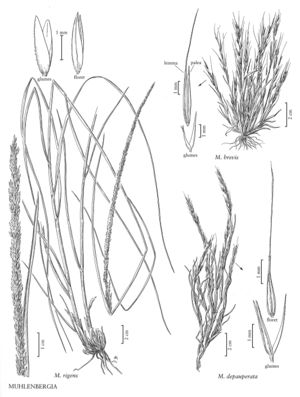Difference between revisions of "Muhlenbergia brevis"
FNA>Volume Importer |
FNA>Volume Importer |
||
| Line 17: | Line 17: | ||
-->{{Treatment/Body | -->{{Treatment/Body | ||
|distribution=Ariz.;Colo.;N.Mex.;Tex. | |distribution=Ariz.;Colo.;N.Mex.;Tex. | ||
| − | |discussion=<p>Muhlenbergia brevis grows on rocky slopes, gravelly flats, and rock outcrops, particularly those derived from calcareous parent materials, at elevations of 1700-2500 m, in gramma grasslands, pinyon-juniper woodlands, and pine-oak woodlands. Its range extends from the southwestern United States to central Mexico.</p><!-- | + | |discussion=<p><i>Muhlenbergia brevis</i> grows on rocky slopes, gravelly flats, and rock outcrops, particularly those derived from calcareous parent materials, at elevations of 1700-2500 m, in gramma grasslands, pinyon-juniper woodlands, and pine-oak woodlands. Its range extends from the southwestern United States to central Mexico.</p><!-- |
| − | --><p>Like Muhlenbergia depauperata, M. brevis shares several features with Lycurus, notably the paired spikelets with 2-veined and 2-awned lower glumes, 1-veined and awned upper glumes, acuminate, awned lemmas with shortly pubescent margins, and pubescent paleas.</p> | + | --><p>Like <i>Muhlenbergia depauperata</i>, <i>M. brevis</i> shares several features with <i>Lycurus</i>, notably the paired spikelets with 2-veined and 2-awned lower glumes, 1-veined and awned upper glumes, acuminate, awned lemmas with shortly pubescent margins, and pubescent paleas.</p> |
|tables= | |tables= | ||
|references= | |references= | ||
| Line 27: | Line 27: | ||
-->{{#Taxon: | -->{{#Taxon: | ||
name=Muhlenbergia brevis | name=Muhlenbergia brevis | ||
| − | |||
|authority=CO. Goodd. | |authority=CO. Goodd. | ||
|rank=species | |rank=species | ||
| Line 34: | Line 33: | ||
|basionyms= | |basionyms= | ||
|family=Poaceae | |family=Poaceae | ||
| − | |illustrator=Linda A. Vorobik | + | |illustrator=Linda A. Vorobik;Annaliese Miller |
| + | |illustration copyright=Utah State University | ||
|distribution=Ariz.;Colo.;N.Mex.;Tex. | |distribution=Ariz.;Colo.;N.Mex.;Tex. | ||
|reference=None | |reference=None | ||
| Line 40: | Line 40: | ||
|publication year= | |publication year= | ||
|special status= | |special status= | ||
| − | |source xml=https:// | + | |source xml=https://jpend@bitbucket.org/aafc-mbb/fna-data-curation.git/src/f50eec43f223ca0e34566be0b046453a0960e173/coarse_grained_fna_xml/V25/V25_779.xml |
|subfamily=Poaceae subfam. Chloridoideae | |subfamily=Poaceae subfam. Chloridoideae | ||
|tribe=Poaceae tribe Cynodonteae | |tribe=Poaceae tribe Cynodonteae | ||
Revision as of 21:37, 16 December 2019
Plants annual; tufted. Culms 3-20 cm. Sheaths often longer than the internodes, somewhat inflated, smooth or scabrous; ligules 1-3 mm, membranous, acute, lacerate, sometimes with lateral lobes; blades 1-4.5 cm long, 0.8-2 mm wide, flat to involute, scabrous to strigose, midveins and margins thickened, whitish. Panicles 3-11.5 cm long, 0.8-1.8 cm wide, contracted; primary branches 1-3.7 cm, closely appressed, spikelets usually in subsessile-pedicellate pairs; pedicels 0.2-8 mm, stout, closely appressed, scabrous; disarticulation beneath the spikelet pairs. Spikelets 2.5-6 mm. Glumes to 2/3 as long as the lemmas; lower glumes 2-3.5 mm, subulate, 2-veined, minutely to deeply bifid, with 2 aristate teeth or awns to 1.8 mm; upper glumes 2.4-4 mm, entire, acuminate to attenuate, 1-veined, awned, awns to 2 mm; lemmas 3.5-6 mm, narrowly lanceolate, light greenish-brown to purplish, scabrous, appressed-pubescent on the margins and mid-veins, apices acuminate, often bifid, awned, awns usually 10-20 mm, stiff; paleas 4-6 mm, narrowly lanceolate, intercostal region appressed-pubescent, apices acuminate; anthers 0.5-0.9 mm, purplish to yellowish. Caryopses 2-2.8 mm, narrowly fusiform, brownish. 2n = 20.
Distribution
Ariz., Colo., N.Mex., Tex.
Discussion
Muhlenbergia brevis grows on rocky slopes, gravelly flats, and rock outcrops, particularly those derived from calcareous parent materials, at elevations of 1700-2500 m, in gramma grasslands, pinyon-juniper woodlands, and pine-oak woodlands. Its range extends from the southwestern United States to central Mexico.
Like Muhlenbergia depauperata, M. brevis shares several features with Lycurus, notably the paired spikelets with 2-veined and 2-awned lower glumes, 1-veined and awned upper glumes, acuminate, awned lemmas with shortly pubescent margins, and pubescent paleas.
Selected References
None.
